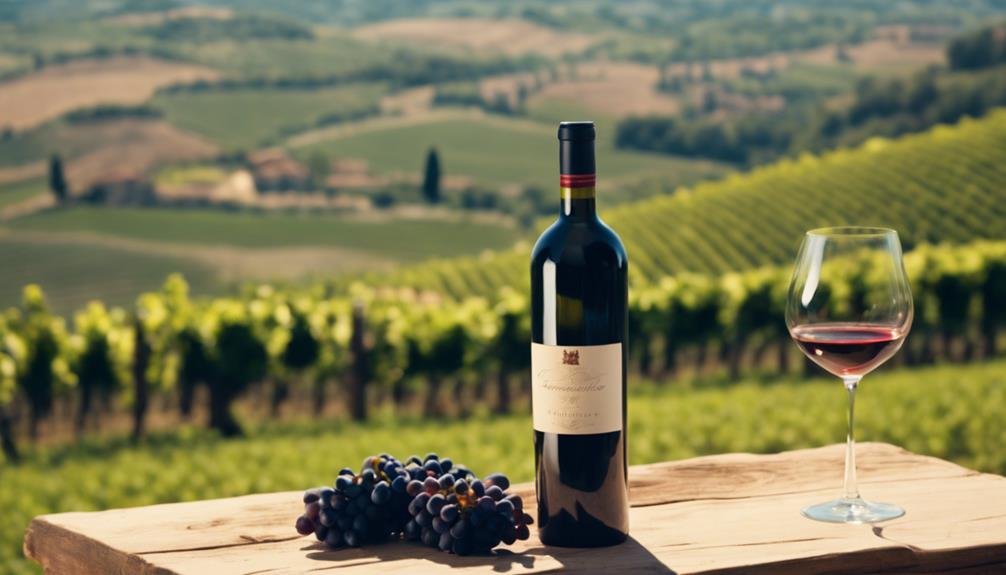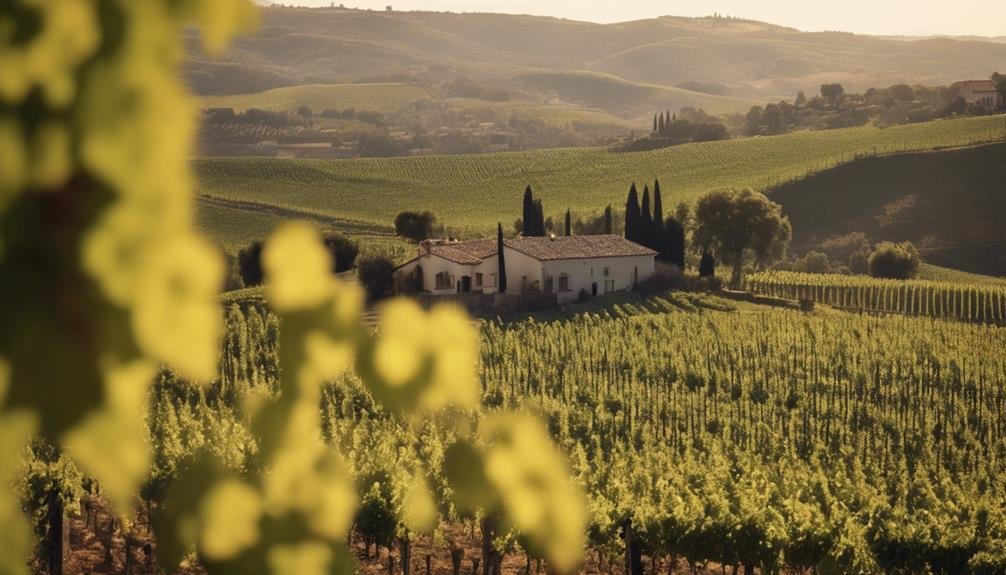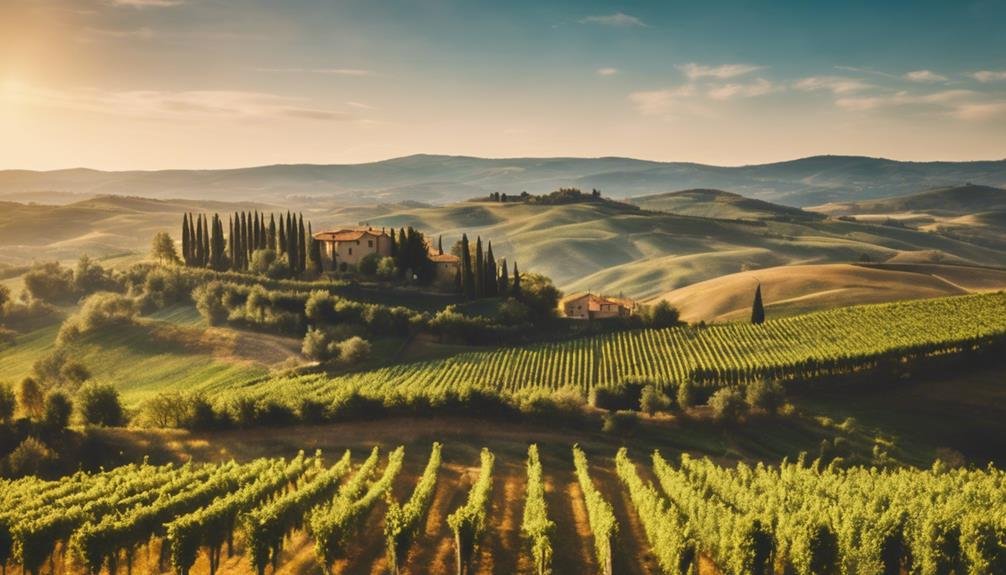Italy's top high-quality wine regions are Veneto, Tuscany, and Piedmont. Veneto excels in reds and the exquisite Soave white wine. Tuscany offers robust red wines like Chianti, showcasing the Sangiovese grape. Piedmont boasts red wines such as Barolo and Moscato d'Asti, with the prized Nebbiolo grape. Each region has unique characteristics contributing to Italy's premier winemaking reputation. Other notable regions include Lombardy for Pinot Nero, Emilia-Romagna for Lambrusco, and Sicily for varietals like Nero d'Avola. Italian wine regions provide a rich tapestry of flavors, solidifying Italy as a top global winemaking destination. More insights await into these regions' intriguing wines.
Top 3 High-Quality Wine Regions
Highlighting the pinnacle of Italian winemaking excellence, the top three high-quality wine regions in Italy are Veneto, Tuscany, and Piedmont.
Exploring unique varietals in these regions uncovers hidden gems in lesser-known areas. Veneto stands out for its reds and the exquisite Soave white wine, with Valpolicella and Amarone della Valpolicella leading the way.
Tuscany offers robust red wines and the delightful Vin Santo, showcasing the renowned Sangiovese grape in the Chianti region.
Piedmont boasts red wines like Barolo and the invigorating Moscato d'Asti, with the Nebbiolo grape as its prized possession.
Each region's distinct characteristics and exceptional wines contribute to Italy's well-deserved reputation as a premier winemaking destination.
Veneto: Reds and Soave Wine
The Veneto region in Italy is renowned for producing exceptional red wines and a luscious white wine known as Soave.
- Veneto's Unique Terroir: The region's diverse landscapes, ranging from rolling hills to flat plains, contribute to the distinctive characteristics of Veneto wines.
- Garganega Grape Characteristics: Garganega, the primary grape used in Soave wine, imparts invigorating citrus notes and a crisp acidity, making Soave a popular choice among white wine enthusiasts.
- Red Wines: In addition to Soave, Veneto is celebrated for its red wines, particularly Valpolicella blends showcasing grapes like Corvina, Rondinella, and Molinara, reflecting the region's commitment to quality and tradition.
Tuscany: Reds and Vin Santo

Renowned for its rich red wines and the sweet delight of Vin Santo, Tuscany stands as a beacon of Italian winemaking excellence. The region is famous for its Chianti wines, primarily crafted from the Sangiovese varietal, known for its vibrant acidity and cherry flavors.
Additionally, Tuscany is home to Super Tuscan blends, which often combine Sangiovese with international varieties like Cabernet Sauvignon and Merlot, creating bold and complex wines that defy traditional Italian winemaking regulations. Tuscany's winemakers have successfully blended tradition with innovation, producing wines that appeal to both purists and modern wine enthusiasts.
With its diverse range of wines and a strong focus on quality, Tuscany continues to captivate wine lovers worldwide.
Piedmont: Reds and Moscato
With a rich heritage of red wines and the renowned Moscato d'Asti, Piedmont stands as a distinguished Italian wine region.
- Exploring Piedmont's diversity: From bold Barolos to elegant Dolcettos, Piedmont offers a diverse range of red wines that showcase the region's winemaking prowess.
- Nebbiolo spotlight: The Nebbiolo grape takes center stage in Piedmont, known for its high tannins and acidity, giving wines like Barolo their distinctive character and aging potential.
- Moscato d'Asti excellence: Piedmont is also celebrated for its delightful Moscato d'Asti, a sweet and aromatic sparkling wine that captivates with its fresh fruit flavors and lively bubbles, perfect for any celebratory occasion.
Other Notable Italian Wine Regions

In addition to Piedmont's renowned red wines and Moscato d'Asti, Italy boasts several other notable wine regions each with distinctive grape varietals and unique wine styles.
Sparkling Lombardy is known for its Pinot Nero and sparkling wines, particularly the prestigious Franciacorta sparkling wine.
Emilia-Romagna stands out for its production of Lambrusco wine, a slightly fizzy red with varying levels of sweetness.
Sicily, on the other hand, is recognized for its Sicilian varietals such as Nero d'Avola and the famous Marsala production, a fortified wine with a rich history.
These regions showcase the diversity of Italian winemaking, each offering a taste of the unique terroir and traditions that define their distinctive wine styles.
Frequently Asked Questions
What Is the Significance of DOC and D.O.C.G. Labels in Italian Wine Regions?
The DOC and D.O.C.G. labels in Italian wine regions are crucial quality assurance indicators. They signify adherence to strict production methods, terroir influence, and aging processes. These labels guarantee consumers wines of specific quality standards and geographical origin.
Are There Any Specific Food Pairing Recommendations for Wines From Veneto?
Food pairings for Veneto wines include rich dishes like grilled meats, risotto, and flavorful cheeses. Cultural influences shape these pairings, emphasizing regional specialties that complement the wines' characteristics, enhancing dining experiences with Veneto's diverse flavors.
How Does the Climate in Tuscany Affect the Flavor Profile of Its Red Wines?
The climate in Tuscany greatly impacts the flavor profile of its red wines. Warm days and cool nights foster grape ripening, enhancing fruitiness and acidity. Mineral-rich soils, like galestro and alberese, contribute to complexity, while aiding in aging potential. Sangiovese, the predominant grape, embodies regional characteristics.
What Makes Nebbiolo Grape Unique in Piedmont Compared to Other Regions?
The Nebbiolo grape in Piedmont showcases its uniqueness through the terroir influence, creating wines with high tannins, acidity, and complex flavors. This grape's expression in Piedmont, especially in Barolo, is distinctive for its elegance and age-worthiness.
Are There Any Traditional Winemaking Techniques Unique to Sicily?
Traditional winemaking techniques in Sicily incorporate ancient methods like sun-drying grapes for sweet wines, utilizing indigenous practices of extended skin contact for robust flavors, and vineyard rituals such as terracing on volcanic soil, all reflecting Sicilian wine secrets and historic traditions.
Conclusion
In the intricate tapestry of Italian wine regions, each bottle tells a story of tradition, excellence, and diversity. Just like a fine wine, Italy's regions offer a symphony of flavors waiting to be discovered and appreciated.
From the bold reds of Veneto to the iconic Sangiovese of Tuscany, and the elegant Moscato of Piedmont, Italian wines invite us on a mesmerizing journey of exploration and enjoyment.
Set off on this wine-filled adventure and savor the richness of Italy's winemaking heritage.
